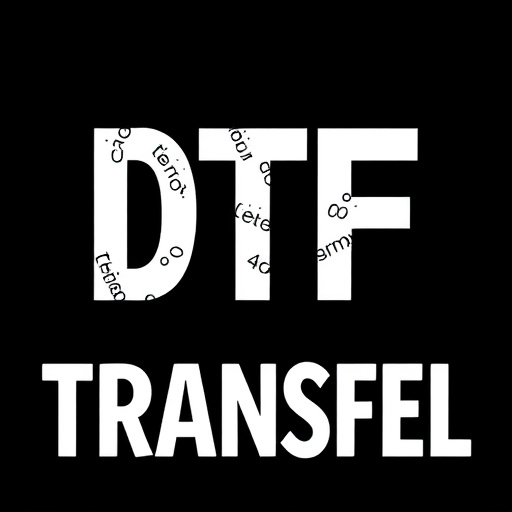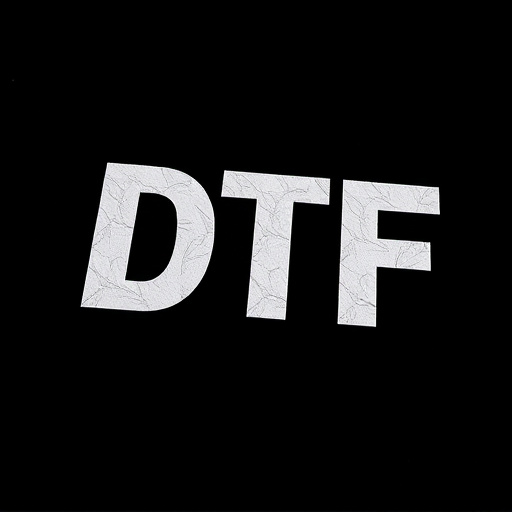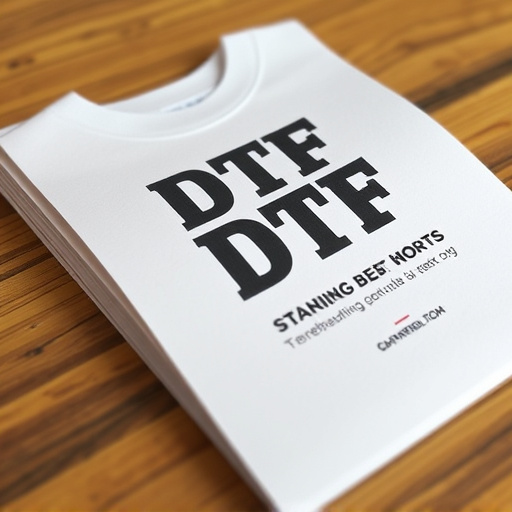Speeding Up DTF Production: 24-Hour Turns and Quality Prints
Direct-to-Film (DTF) transfers are a cutting-edge solution for swift and efficient creation of high-…….
In the fast-paced world of manufacturing and design, the concept of same-day Direct To Final (DTF) printing has emerged as a game-changer. This cutting-edge technology allows for the rapid production of physical prototypes or end-use parts, enabling designers, engineers, and manufacturers to streamline their processes and bring products to market faster. This comprehensive article aims to unravel the intricacies of same-day DTF printing, exploring its impact, benefits, and potential challenges. By delving into various aspects, from its technical foundations to global implications, readers will gain a thorough understanding of this transformative process.
Definition: Same-day DTF printing refers to a digital manufacturing technique that facilitates the immediate production of 3D-printed parts or prototypes using advanced materials and direct printing to final form technology. It eliminates the need for traditional intermediate steps, such as building up layers or applying separate finishes.
At its core, DTF printing combines elements of 3D printing, computer-aided design (CAD), and precision engineering. The process involves creating a digital model using CAD software, which is then prepared for printing. Specialized software slices the design into thin layers, generating instructions for a high-precision printer. Unlike traditional 3D printing methods that build up material layer by layer, DTF printers use advanced materials and techniques to directly print the final shape, often with excellent surface finish and intricate details.
Historical Context: The roots of same-day DTF printing can be traced back to the early developments in additive manufacturing. As 3D printing technology evolved, engineers and researchers sought ways to streamline the production process, reduce time, and enhance material capabilities. Over the years, significant advancements in materials science, printer design, and digital slicing algorithms have contributed to the emergence of same-day DTF printing as a viable solution.
Significance: Same-day DTF printing holds immense importance in various industries, including manufacturing, automotive, aerospace, medical devices, and consumer goods. Its significance lies in several key factors:
Rapid Prototyping: It enables designers and engineers to quickly transform digital designs into physical prototypes, facilitating faster iteration and design refinement. This speed is particularly valuable in product development cycles where time-to-market is critical.
Cost Efficiency: By eliminating the need for lengthy build times, complex tooling, or multiple production stages, same-day DTF printing can significantly reduce manufacturing costs. It minimizes material waste and optimizes resource utilization, making it an attractive option for low to medium volume production runs.
Customization: The process allows for easy customization of designs, enabling the rapid creation of unique, personalized products or prototypes tailored to specific customer needs. This level of flexibility is particularly advantageous in markets demanding diverse, customized offerings.
Rapid Quality Assessment: With same-day printing, designers can promptly evaluate the aesthetic and functional qualities of their creations. This real-time feedback loop accelerates design refinement and ensures that final products meet or exceed expectations.
The impact of same-day DTF printing extends across borders, shaping global manufacturing landscapes and driving innovation in diverse regions.
International Adoption: This technology has gained traction worldwide, with early adopters leading the way in various sectors. Countries known for their advanced manufacturing capabilities, such as the United States, Germany, Japan, and South Korea, have actively embraced same-day DTF printing, contributing to its global spread. Additionally, regions with thriving design and startup ecosystems, like Silicon Valley and parts of Asia Pacific, are leveraging this technology to foster innovation and entrepreneurship.
Regional Trends: Different regions are witnessing unique applications and adaptations of same-day DTF printing:
| Region | Key Applications & Trends |
|---|---|
| North America | Dominant in automotive and aerospace sectors, with companies like Ford and Boeing utilizing DTF printing for rapid prototyping and tooling. |
| Europe | Focus on medical device manufacturing and jewelry design, leveraging high-resolution printing capabilities to create intricate, precise parts. |
| Asia Pacific | Strong presence in consumer electronics and fashion industries, enabling quick turnaround times for product development and customization. |
| Middle East & Africa | Emerging as hubs for advanced manufacturing, with governments investing in DTF printing infrastructure to support local industries. |
Global Market Dynamics: The global same-day DTF printing market is experiencing significant growth, driven by factors such as:
The economic implications of same-day DTF printing are profound, influencing local and global markets in numerous ways.
Market Dynamics: The technology disrupts traditional supply chains by streamlining production processes. This results in reduced lead times, lower production costs, and improved product availability. In competitive markets, manufacturers can gain a significant advantage by offering faster turnaround times and more flexible production capabilities.
Job Market Impact: While same-day DTF printing may displace some routine manufacturing tasks, it also creates new job opportunities. Skilled technicians, materials scientists, CAD designers, and quality assurance specialists are in demand to operate and optimize these advanced systems. Additionally, the rise of on-demand production and localized manufacturing could reshape geographical employment patterns.
Cost Analysis: Initial investment costs for same-day DTF printing equipment can vary widely, depending on printer complexity, build volume, and material capabilities. However, over time, the technology offers substantial cost savings by reducing waste, minimizing tool expenses, and streamlining production processes. This makes it particularly attractive for businesses aiming to optimize their manufacturing spend.
Global Trade and Supply Chains: As DTF printing becomes more widespread, it has the potential to fragment global supply chains. Localized production capabilities could enable regions to meet regional demands more efficiently, reducing reliance on international trade. This shift may impact global logistics, shipping routes, and existing economic power dynamics.
The success of same-day DTF printing is intricately tied to advancements in materials science, ensuring the development of high-performance materials capable of meeting stringent technical requirements.
Materials Used: A wide range of thermoplastics, elastomers, and composite materials are suitable for DTF printing. These include:
Thermoplastics: Polycarbonate (PC), Acrylonitrile Butadiene Styrene (ABS), Polylactic Acid (PLA), and Nylon offer excellent mechanical properties, heat resistance, and versatility in design possibilities.
Elastomers: Silicone and TPU (thermoplastic polyurethane) materials are ideal for creating flexible, rubber-like parts with good wear resistance and durability.
Composite Materials: Fiber-reinforced composites, such as carbon fiber-infused polymers, offer enhanced mechanical performance, making them suitable for high-stress applications in aerospace and automotive industries.
Material Properties: Key material properties that enable same-day DTF printing include:
Flow and Viscosity: Materials must have the right balance between flow characteristics to ensure precise printing and the ability to fill intricate geometries without defects.
Thermal Properties: High-temperature stability is crucial for printing complex parts, as materials should not deform or degrade during the printing process.
Mechanical Strength: Printed parts require adequate tensile strength, impact resistance, and fatigue durability to withstand real-world applications.
Surface Finish: Smooth and consistent surface finishes are desirable to ensure aesthetic appeal and facilitate subsequent finishing processes like painting or coating.
While same-day DTF printing offers numerous advantages, it also presents technical challenges that drive ongoing research and innovation.
Precision and Layer Resolution: Achieving fine layer resolution is critical to produce intricate details and complex geometries accurately. Researchers are developing advanced slicing algorithms and printer mechanisms to improve precision, ensuring consistent quality across printed parts.
Build Speed vs. Quality: Balancing print speed and part quality remains a focus area. As printers strive to achieve faster build times, maintaining dimensional accuracy and material properties becomes increasingly challenging. Continuous research aims to optimize print paths and material behavior to meet stringent tolerances.
Material Interdiffusion and Fusing: In multi-material printing, ensuring proper material fusion and preventing interdiffusion between layers is essential for part integrity. Scientists are exploring novel materials and printing techniques to address these challenges, enabling the creation of complex multi-material structures.
Post-Processing Integration: Streamlining post-processing steps, such as support removal, cleaning, and finishing, is crucial for efficient DTF printing workflows. Integrating these processes into the automated printing pipeline can significantly reduce production times and costs.
Same-day DTF printing has found its way into various industries, leaving a mark on product design, development, and manufacturing.
Automotive: In the automotive sector, DTF printing is used for rapid prototyping of components, toolmaking, and even low-volume production runs. It enables designers to quickly iterate on complex geometric designs, ensuring optimal performance and lightweighting.
Aerospace: The aerospace industry leverages same-day DTF printing for rapid manufacturing of engine components, fuel nozzles, and intricate structural parts. The ability to produce high-precision, complex geometries directly from digital designs reduces production times and costs associated with traditional manufacturing methods.
Medical Devices: From prototyping to small-batch production, DTF printing is revolutionizing medical device manufacturing. It enables the creation of personalized devices tailored to individual patient needs, such as custom prosthetics, dental implants, and surgical instruments.
Consumer Electronics: Rapid iteration and customization are key drivers in consumer electronics. DTF printing allows manufacturers to quickly produce prototypes, test designs, and even offer personalized accessories or replacement parts for popular gadgets.
Art and Design: Beyond functional applications, same-day DTF printing has found its place in artistic endeavors. Designers can create unique, complex sculptures, jewelry, and architectural models with intricate details and organic shapes.
The future of same-day DTF printing looks promising, with ongoing research and development opening up new avenues for innovation.
Multi-Material and Multi-Functional Printing: Researchers are exploring ways to print multiple materials simultaneously, enabling the creation of parts with distinct mechanical, thermal, or electrical properties. This could lead to advanced composite materials and multi-functional devices.
Biomimicry and Natural Material Replication: Drawing inspiration from nature, scientists aim to develop biocompatible materials and printing techniques that mimic organic structures and functions. This could revolutionize medical implants, tissue engineering scaffolds, and sustainable material production.
Integration with AI and Machine Learning: Artificial intelligence can optimize print paths, predict part behavior, and enhance material selection based on design requirements. Machine learning algorithms can learn from vast datasets to improve printing processes, ensuring consistent quality and efficiency.
Desktop Manufacturing and On-Demand Production: As technology advances, same-day DTF printing may become more accessible, even in desktop formats. This could enable individuals, small businesses, and makers to produce custom parts and products on demand, fostering innovation and local manufacturing.
Same-day DTF printing represents a significant leap forward in additive manufacturing, offering unprecedented design freedom, rapid prototyping capabilities, and localized production. It has the potential to revolutionize various industries, from automotive and aerospace to medical devices and consumer electronics. As technology continues to evolve, addressing technical challenges, and exploring new materials and applications, same-day DTF printing will undoubtedly shape the future of manufacturing, enabling innovative products and processes that were once considered impossible.

Direct-to-Film (DTF) transfers are a cutting-edge solution for swift and efficient creation of high-…….

Direct-to-Film (DTF) transfers are revolutionizing printing with swift 24-hour turnaround times, del…….

Direct-to-Film (DTF) printing transforms film production with its swift, modern approach, eliminatin…….

DTF Prints represent a revolutionary advancement in film production, offering swift creation of high…….

DTF Printing is a revolutionary process that dramatically reduces film transfer times from days/week…….

DTF Printing (Direct-to-Film) is a game-changing technique offering efficient, high-quality printing…….

DTF Printing is a cutting-edge technique revolutionizing the printing industry by directly transferr…….

DTF Printing (Direct-to-Film) is a cutting-edge technology offering swift, high-quality film transfe…….

Direct-to-Film (DTF) printing is a cutting-edge technology revolutionizing photo printing with swift…….

Direct-to-Film (DTF) Transfers revolutionize film preservation with a swift 24-hour turnaround, offe…….